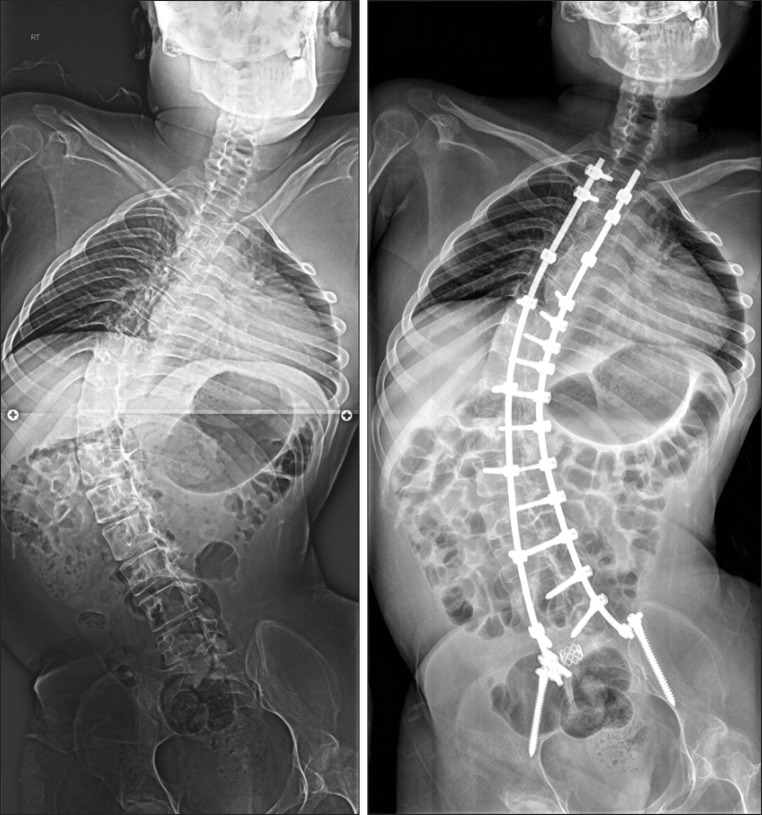Ann Rehabil Med.
2013 Dec;37(6):875-878. 10.5535/arm.2013.37.6.875.
Successful Surgery for Scoliosis Supported by Pulmonary Rehabilitation in a Duchenne Muscular Dystrophy Patient With Forced Vital Capacity Below 10%
- Affiliations
-
- 1Department of Rehabilitation Medicine and Rehabilitation, Institute of Neuromuscular Disease, Yonsei University College of Medicine, Seoul, Korea. kswoong@yuhs.ac
- 2Department of Rehabilitation Medicine, Ewha Womans University School of Medine, Seoul, Korea.
- KMID: 2266567
- DOI: http://doi.org/10.5535/arm.2013.37.6.875
Abstract
- Low vital capacity is a risk factor for scoliosis correction operation in Duchenne muscular dystrophy (DMD) patients, but pulmonary rehabilitation, including noninvasive intermittent positive pressure ventilator application, air stacking exercise, and assisted coughing technique, reduces the pulmonary complications and perioperative mortality risk. In this case, the patient's preoperative forced vital capacity (FVC) was 8.6% of normal predicted value in sitting position and 9.4% in supine position. He started pulmonary rehabilitation before the operation and continued right after the operation. Scoliosis correction operation was successful without any pulmonary complications, and his discomfort in sitting position was improved. If pulmonary rehabilitative support is provided properly, FVC below 10% of normal predicted value is not a contraindication of scoliosis correction operation in DMD patients.
MeSH Terms
Figure
Reference
-
1. Rawlins BA, Winter RB, Lonstein JE, Denis F, Kubic PT, Wheeler WB, et al. Reconstructive spine surgery in pediatric patients with major loss in vital capacity. J Pediatr Orthop. 1996; 16:284–292. PMID: 8728627.
Article2. Kang SW. Pulmonary rehabilitation in patients with neuromuscular disease. Yonsei Med J. 2006; 47:307–314. PMID: 16807978.
Article3. Takaso M, Nakazawa T, Imura T, Okada T, Fukushima K, Ueno M, et al. Surgical management of severe scoliosis with high risk pulmonary dysfunction in Duchenne muscular dystrophy: patient function, quality of life and satisfaction. Int Orthop. 2010; 34:695–702. PMID: 20155495.
Article4. Gill I, Eagle M, Mehta JS, Gibson MJ, Bushby K, Bullock R. Correction of neuromuscular scoliosis in patients with preexisting respiratory failure. Spine (Phila Pa 1976). 2006; 31:2478–2483. PMID: 17023858.
Article5. Cheuk DK, Wong V, Wraige E, Baxter P, Cole A, N'Diaye T, et al. Surgery for scoliosis in Duchenne muscular dystrophy. Cochrane Database Syst Rev. 2007; (1):CD005375. PMID: 17253553.
Article6. Larsson EL, Aaro SI, Normelli HC, Oberg BE. Long-term follow-up of functioning after spinal surgery in patients with neuromuscular scoliosis. Spine (Phila Pa 1976). 2005; 30:2145–2152. PMID: 16205339.7. Master DL, Son-Hing JP, Poe-Kochert C, Armstrong DG, Thompson GH. Risk factors for major complications after surgery for neuromuscular scoliosis. Spine (Phila Pa 1976). 2011; 36:564–571. PMID: 20683386.
Article8. Sussman MD. Advantage of early spinal stabilization and fusion in patients with Duchenne muscular dystrophy. J Pediatr Orthop. 1984; 4:532–537. PMID: 6490869.9. Yamashita T, Kanaya K, Yokogushi K, Ishikawa Y, Minami R. Correlation between progression of spinal deformity and pulmonary function in Duchenne muscular dystrophy. J Pediatr Orthop. 2001; 21:113–116. PMID: 11176364.
Article10. Kang SW, Cho DH, Lee SC, Moon JH, Park YG, Song NK, et al. Clinical implication of air stacking exercise in patients with neuromuscular diseases. J Korean Acad Rehabil Med. 2007; 31:346–350.
- Full Text Links
- Actions
-
Cited
- CITED
-
- Close
- Share
- Similar articles
-
- Clinical Implications of Pulmonary Function Test and Maximum Static Pressure in Duchenne Muscular Dystrophy
- Perioperative Evaluation of Respiratory Muscle Strength after Scoliosis Correction in Patients with Duchenne Muscular Dystrophy
- Clinical Implications of Inspiratory Muscle Training in Patients with Duchenne Muscular Dystrophy
- Comparison of Pulmonary Functions at Onset of Ventilatory Insufficiency in Patients With Amyotrophic Lateral Sclerosis, Duchenne Muscular Dystrophy, and Myotonic Muscular Dystrophy
- Postural Change of Vital Capacity in Patients with Neuromuscular Disease


